California mission records show our maternal 4th Great Grandpa Jose Maria was born Jose Maria Verdugo (also prounced as Berdugo) in approximately 1751 in Spanish colonial Loreto, Baja California, Mexico.
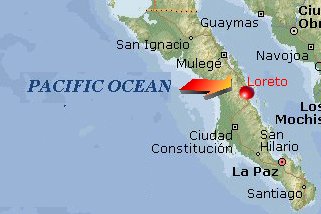 Jose Maria Verdugo's birth city, Loreto, Baja Ca., Mx. (Click to enlarge)
Jose Maria Verdugo's birth city, Loreto, Baja Ca., Mx. (Click to enlarge)
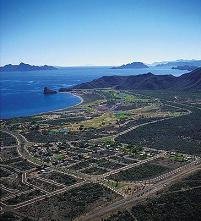 Jose Maria Verdugo's birth city, Loreto
Jose Maria Verdugo's birth city, Loreto
According to Marie E. Northrup's
Spanish-Mexican Families of Early California: 1769-1850 Volume II, Jose Maria was the third of six children born to Juan Diego Verdugo, a Baja soldier, and Maria Ygnacia de la Concepcion Carrillo.
The
Ancestry World Tree has entries claiming up to three additional children in this family, the validity of which is questionable until such time as referenced reliable sources are provided.
A Brief History of Mexico and Baja California:
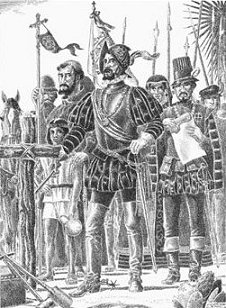 Spanish Conquistador Hernan Cortes
Spanish Conquistador Hernan Cortes
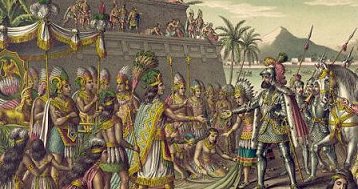 Montezuma Greets Cortes in Tenochtitlan
Montezuma Greets Cortes in Tenochtitlan
In 1521 Spanish conquistador Hernan Cortes defeated the Aztec King, Montezuma, captured the Aztec capital, Tenochtitlan, and renamed the capital Mexico City.
Cortes was appointed governor of the captured Aztec empire which was renamed "New Spain" (and later called Mexico).
In 1536 Cortes discovered the Baja Penninsula and named it California. Baja (Lower) California referred to the penninsula and Alta (Upper) California referred to the territory to the north of it.
Baja remained unconquerable after many failed attempts until 1697, when Spanish Jesuit priests crossed the Sea of Cortes from Mexico and established their first permanent mission in Loreto,
Mission Nuestra Senora de Loreto.
Soon after the
Royal Presidio of Loreto was built and the pueblo of Loreto developed (eventually becoming the capital of Baja).
 Mission Nuestra Senora de Loreto
Mission Nuestra Senora de Loreto
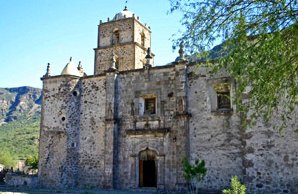 Typical Jesuit Mission, Baja
Typical Jesuit Mission, Baja
Spain's system of colonization consisted of building a community
mission and
pueblo (town). A
presidio (royal fort) was built to defend multiple communities. All were controlled by the military governor and the presidio commandant.
It is here, in Loreto, where Jose Maria Verdugo was born, grew into manhood, and utimately, like his father and brother before him, enlisted as a soldier at the Royal Presidio.
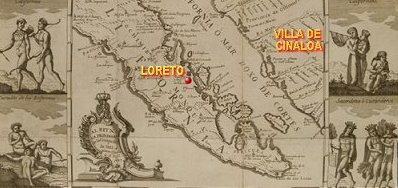 1739: The Indians & Baja Habitat Into Which Jose Maria Was Born (Click to enlarge)
1739: The Indians & Baja Habitat Into Which Jose Maria Was Born (Click to enlarge)
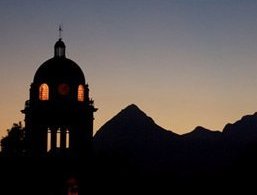 Baja Mission
Baja Mission
Jose Maria's Journey to Alta California
Marie E. Northrup, an early-California historian, lists
Josef Maria Verdugo as being a
soldado de cuera* recruited for Portola's 1769 expedition to Alta California. (*SEE DESCRIPTION BELOW)
Records show this is our 4th Great Grandfather Jose Maria Verdugo.
Historian, Hubert Howe Bancroft's
California Pioneer Register and Index 1542-1848 lists Jose Maria as belonging to the group of earliest pioneers who came to Alta California in 1769-73.
A Brief History of Portola's 1769 Expedition to Occupy Alta California:
 A Scenerio Typical of Portola's 1769 Expedition
A Scenerio Typical of Portola's 1769 Expedition
In 1769 Spanish King Carlos III felt Russia and England's land expansions threatened Spanish-held territories in North America.
New Spain's (later named Mexico) Visitador General, Jose de Galvez

, under orders to "Occupy and fortify San Diego and Monterey for God and the King of Spain", organized an expedition to Alta California using Sebastian Vizcaino's

old 1602 map with descriptions of California's coastline (drawn by Carmelite friar, Antonio de la Ascensíon, who accompanied Vizcaino. Some think the friar drew California as an island to confuse and deter other explorers).
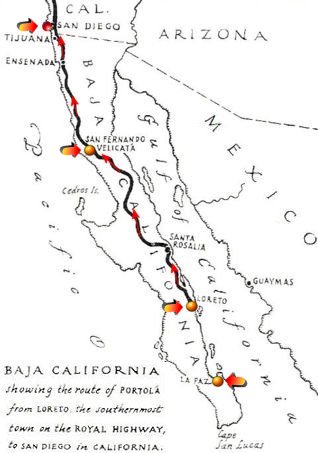 Portola's 1769 Expedition Overland Route
Portola's 1769 Expedition Overland Route
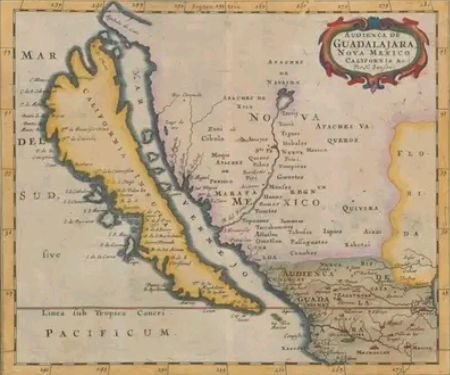 Vizcaino 1602 California map, drawn as an island (CLICK TO ENLARGE)
Vizcaino 1602 California map, drawn as an island (CLICK TO ENLARGE)
California's Governor Gaspar de Portola

was the expedition commander, which was based at Mission San Fernando Velicata (Baja, California).
The expedition consisted of
two overland parties and
three supply ships, all of which were to rendezvous in San Diego.
Overland Party One: 27 Loreto Presidio Soldado De Cueras* & Indians: Led by Commandant Captain Fernando de Rivera y Moncada

.
Great Grandpa Jose Maria Verdugo and his brother, Mariano Verdugo, were among Rivera's 27 Loreto Presidio soldados de cuera in this party.
Overland Party Two: 10 Additional Soldado De Cueras* & Indians: Led by Gov. Portola. Father Serra

(Presidente of Alta California Missions) also traveled with this group.
Three Supply Ships: Led by Lieutenant Pedro Fages (Alta California's future governor)

which left from La Paz.
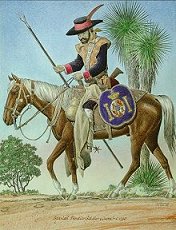 Soldado de Cuera
Soldado de Cuera
* The soldado de cuera (leather-jacket soldier) wore leather armor (cuera), a knee-length, multi-layered leather coat for protection from indian arrows. In addition each wore a sort of a leather apron, which the Spanish called "armas" or "defensas," fastened to the pommel of the saddle and hanging down on both sides to protect the thighs and legs in thickets and woods.
He carried a shield, musket, 2 pistols, sword, dagger and lance.
The Spanish considered him to be the "best horseman in the world".
On March 24, 1769,
Party One led by Rivera (including Eighteen-year-old Jose Maria Verdugo) set out from
Velicata for Alta California with horses, mules, cattle and supplies. They traveled northward along the El Camino Real (The King's Highway), a mere footpath. The party's Indians built the road through mountains and across gullies.
Seven weeks later on May 15, 1769
Party Two led by Portolo set out from
Velicata for Alta California, following the roads built by Party One.
Hungry and thirsty, members of the land parties picked their way through territory never before explored by white men.
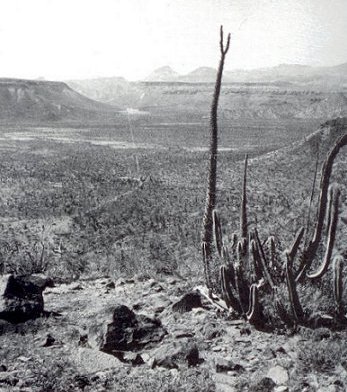 El Camino Real - The King's Highway
El Camino Real - The King's Highway

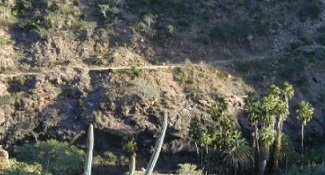 El Camino Real - The King's Highway
El Camino Real - The King's Highway
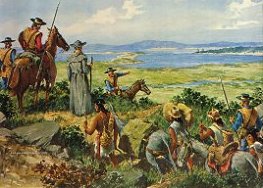 Rivera's Party One Reaches San Diego 14 May 1769
Rivera's Party One Reaches San Diego 14 May 1769
Approximately 52 days and 300 miles later, on May 14, 1769 Rivera's
Party One reached San Diego.
Two ships were anchored in the bay (a third ship had vanished and was presumed lost at sea).
On July 1, 1769 Portola's
Party Two arrived at San Diego. The
Royal Presidio of San Diego was established with Governor Gaspar de Portola claiming "Alta California" as a territory of Spain.
The journey had been difficult. Half of the expedition had perished. Most of the Baja California Indians had deserted or died.
Up to one third of the men on the ships were ill or had died from scurvy, and many of the survivors were sick and exhausted.
On July 14, 1769 Portola and sixty-three weakened and hungry men (Portola remarked they were nothing but skeletons) headed north to find Monterey. Father Serra stayed behind with 40 men. Portolo ordered the ship San Antonio back to San Blas for supplies,
leaving the San Carlos at anchor for lack of adequate crew.
On July 16, 1769, two days after Portola's departure, Father Serra erected a crude brushwood shelter and dedicated the first Alta California mission,
Mission San Diego de Alcala.
On August 15, 1769, in Portolo's absence, Indians attacked Father Serra's camp which had only four soldiers, wounding some and killing a young servant.
On January 24, 1770, after a six-month absence, Portola's famished party returned to San Diego, having failed to find Monterey. (He later realized he had been at Monterey Bay port but it was hidden by fog.) Only twenty men were left alive in San Diego.
In February 1770 Portola sent Rivera and 40 men back down the Baja Peninsula to gather critically-needed supplies.
On March 19, 1770, after weeks of acute hunger and increased sickness, Portola had prepared to abandon San Diego and go back to Velicata. He stated, "There were not enough provisions to wait longer and the men had not come to perish from hunger."
Fortunately, the supply ship San Antonio arrived from San Blas late that very afternoon, thereby saving the expedition.
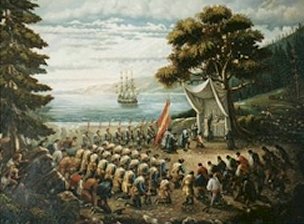 Dedication Of Mission San Carlos Borromeo, Monterey 1770
Dedication Of Mission San Carlos Borromeo, Monterey 1770
In the Spring of 1770 a second attempt to locate Monterey was successful.
In June 1770 the
Royal Presidio of San Carlos de Monterey and
Mission San Carlos Borromeo (moved to Carmel 11 months later) were established.
It was a difficult beginning, but slowly and surely over the next few years Spain established missions, presidios, and pueblos along Alta California's coast, thereby securing her foothold in this new territory.
Jose Maria Verdugo's Life in Alta California: Below is a a chronology of Great Grandfather Jose Maria's life in Alta California using the following format:
Date - City - Where in City
RECORD/EVENT, and an explanation of the event.
May 1769 - San Diego - Encampment
 PORTOLA EXPEDITION
PORTOLA EXPEDITION: Jose Maria is listed as Josef Maria Verdugo on list of expedition members prepared by Marie E. Northrup; her reference sources included mission and garrison records, California Padrones (censuses), pioneer indexes, and other early-California-history books and records.
 Mission San Carlos Borromeo de Carmelo
Mission San Carlos Borromeo de Carmelo
13 Jul 1772 - Monterey - Mission San Carlos Borromeo de Carmelo
 MISSION BAPTISM RECORD
MISSION BAPTISM RECORD: Jose Maria is listed as a padrino (godfather) for a converted Indian's baptism.
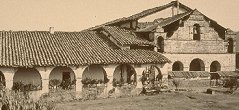 Mission San Antonio de Padua
Mission San Antonio de Padua
1 Jan 1775 - South of Monterey - Mission San Antonio de Padua
 ALTA CALIFORNIA PADRON (CENSUS)
ALTA CALIFORNIA PADRON (CENSUS): Jose Maria is listed as being attached to the garrison
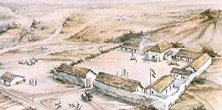 Royal Presidio of San Diego
Royal Presidio of San Diego
Autumn 1775 - San Diego - Royal Presidio
 PARENTS ARRIVE FROM BAJA CALIFORNIA
PARENTS ARRIVE FROM BAJA CALIFORNIA: Jose Maria's parents and younger siblings arrive from Baja California.
His father, Juan Diego Verdugo (also a soldier), is attached to the San Diego Presidio (according to Herbert O. Brayer in his 1943 article,
Ranchero).
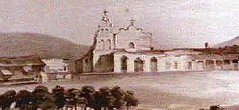 Mission San Diego de Alcala
Mission San Diego de Alcala
4 Nov 1775 - San Diego - Mission San Diego de Alcala
 INDIAN ATTACK
INDIAN ATTACK: Jose Maria's 14-year-old brother, Leonardo Verdugo, is present, but unharmed. He came from the presidio to the mission to hear mass the next day.
At about 1:30 A.M., on a brilliantly-lit night, 600 to 1,000 Indians attack and burn the mission, killing Padre Luis Jayme, the blacksmith (Jose Romero) and a carpenter named Urselino.
 Mission San Gabriel Arcangel
Mission San Gabriel Arcangel
Dec 1777 - San Gabriel - Mission San Gabriel Arcangel
 GARRISON LIST
GARRISON LIST: Jose Maria is assigned as a guard to the mission, attached to the Royal Presidio of San Diego garrison.
7 Nov 1779 - San Gabriel - Mission San Gabriel Arcangel
 MISSION MARRIAGE RECORD
MISSION MARRIAGE RECORD: Jose Maria marries Maria de la Encarnacion Lopez (probably met her at San Diego Presidio where her father, Jose Ignacio Lopez, was attached as a soldier).
Jan 1780 - San Gabriel - Mission San Gabriel Arcangel

 MISSION DEATH RECORD
MISSION DEATH RECORD: Jose Maria's father, Juan Diego Verdugo, dies and is buried inside the church on 24 January 1780. Afterwards Jose Maria's mother, Maria Ygnacia Carrillo Verdugo, moves to the mission to reside.
 GARRISON LIST
GARRISON LIST: Private Jose Maria is still assigned as a guard to the mission, attached to the Royal Presidio of San Diego garrison.
15 Dec 1780 - San Gabriel - Mission San Gabriel Arcangel
 MISSION BAPTISM RECORD
MISSION BAPTISM RECORD: Jose Maria's first child is born, a daughter, Maria Josefa Antonia Verdugo, and is baptized the next day at the mission.
20 May 1782 - San Gabriel - Mission San Gabriel Arcangel
 GARRISON LIST
GARRISON LIST: Jose Maria is now a corporal, assigned in charge of the mission's escolta (guards), attached to the Royal Presidio of San Diego garrison.
16 Jan 1783 - San Gabriel - Mission San Gabriel Arcangel

 MISSION BAPTISM AND DEATH RECORDS
MISSION BAPTISM AND DEATH RECORDS: Jose Maria's second child is born, a son, Juan Maria Verdugo, who is urgently baptized by his grandmother, Maria Ygnacia Carrillo Verdugo.
Sadly the baby dies soon after birth, and is buried the next day at the mission.
 Rancho San Rafael
Rancho San Rafael
20 Oct 1784 - Rancho San Rafael
 LAND GRANT
LAND GRANT: Jose Maria requests and receives the third land grant in Alta California from Governor Fages for 36,403 acres.
The land is located north of Pueblo Los Angeles and nestled between Missions San Fernando del Rey on the west and San Gabriel on the east.
He names the land, La Zanja (the ditch), which later becomes known as the Rancho de los Verdugos or Rancho San Rafael.
1 Dec 1784 - San Gabriel - Mission San Gabriel Arcangel
 GARRISON LIST
GARRISON LIST: Corporal Jose Maria is still assigned in charge of the the mission's escolta, attached to the Royal Presidio of San Diego garrison.
20 Mar 1785 - San Gabriel - Mission San Gabriel Arcangel
 MISSION BAPTISM RECORD
MISSION BAPTISM RECORD: Jose Maria's third child is born, a daughter, Maria Antonia Martina Verdugo, and is baptized the next day at the mission.
25 Oct 1785 - San Gabriel - Mission San Gabriel Arcangel
 INDIAN PLOT
INDIAN PLOT: Jose Maria learns of an Indian plot to attack the mission and quickly prevents the success of the scheme. He takes some twenty Indians prisoner, and they receive punishment at the direction of the governor.
20 Sep 1787 - San Gabriel - Mission San Gabriel Arcangel
 MISSION BAPTISM RECORD
MISSION BAPTISM RECORD: Jose Maria's fourth child is born and baptized, a daughter, Maria Ignacia Eustaquia Verdugo, and is baptized the same day at the mission.
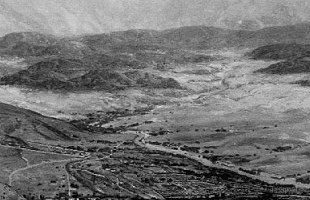 Pueblo De Los Angeles
Pueblo De Los Angeles
31 Dec 1787 (Dated 24 April 1788) - Los Angeles - Pueblo
 1787 PUEBLO POBLADORES LIST
1787 PUEBLO POBLADORES LIST: Jose Maria is listed under Soladados - Cabo Jose Verdugo.
23 May 1788 - Rancho San Rafael
 LIVESTOCK BRAND
LIVESTOCK BRAND: Jose Maria requests and receives a brand from Governor Fages so that he might protect his stock (petitioners had to have at least 150 head of breeding cattle in order to request a brand).
23 Dec 1789 - San Gabriel - Mission San Gabriel Arcangel
 MISSION BAPTISM RECORD
MISSION BAPTISM RECORD: Jose Maria's fifth child is born, a son, Julio Antonio Joseph Verdugo, and is baptized at mission San Gabriel the next day.
31 Dec 1789 - Los Angeles - Pueblo
 1789 PUEBLO POBLADORES LIST
1789 PUEBLO POBLADORES LIST: Jose Maria is listed under Militares - Cabo Jose Verdugo.
1790 - Los Angeles - Pueblo
 ALTA CALIFORNIA PADRON (CENSUS)
ALTA CALIFORNIA PADRON (CENSUS): Jose Maria Verdugo, corporal, espanol, from Loreto, 37; wife Maria Lopez, espanola, [from Real de San Antonio, Baja California], 24; four children: Maria Josefa Antonia] 11; [Maria Antonia Martina] 5; (Maria Ignacia] 3; [Julio] a baby {born 20 Dec 1789}.
31 Dec 1790 - Los Angeles - Pueblo
 1790 PUEBLO POBLADORES LIST
1790 PUEBLO POBLADORES LIST: Jose Maria is listed under Milicias - Cabo Jose Verdugo.
25 Nov 1792 - San Gabriel - Mission San Gabriel Arcangel
 MISSION BAPTISM RECORD
MISSION BAPTISM RECORD: Jose Maria's sixth child is born, a daughter, Catalina Maria Antonia Verdugo, and is baptized at the mission the next day.
31 Dec 1794 - San Gabriel - Mission San Gabriel Arcangel
 GARRISON LIST
GARRISON LIST: Corporal Jose Maria is still assigned in charge of the the mission's escolta, attached to the Royal Presidio of San Diego garrison.
 Typical Married Couple
Typical Married Couple
8 Jan 1795 - San Gabriel - Mission San Gabriel Arcangel
 MISSION MARRIAGE RECORD
MISSION MARRIAGE RECORD: Jose Maria's oldest daughter, 15-year-old Maria Josefa, is married to Joseph Antonio Lugo, a soldier stationed at Santa Barbara.
Jose Maria can only afford a small dowry for Maria Josefa, consisting of one silver horseshoe, one bridle, six horses, two mares, and one pair of spurs.
Oct 1795 - San Gabriel - Mission San Gabriel Arcangel
 MISSION BAPTISM RECORD
MISSION BAPTISM RECORD: Jose Maria's seventh child is born, a daughter, Maria del Pilar Lopez Verdugo, and is baptized on 12 October 1795 at the mission.
29 Dec 1795 - Alta California
 SHEEP REQUIRED ON RANCHEROS
SHEEP REQUIRED ON RANCHEROS: Governor Diego de Borica decrees that unless rancheros keep sheep they would have to live at the pueblos.
Late 1797 - San Gabriel - Mission San Gabriel Arcangel
MILITARY ORDERS TO RELOCATE: Forty-six-year-old Corporal Jose Maria receives San Diego military commander Lieutenant Antonio Grajera's transmission of Governor Borica's order recalling Jose Maria and ordering him to proceed with his family either to the Pueblo de Los Angeles, San Jose, or to the town of Branciforte.
It further states that if he desires to settle at one of the presidios, it must be with the understanding that he was subject to guard duty.
This may have been the driving force behind Jose Maria's decision to request retirement when he did, so as to ensure the ability to support his large family and maintain Rancho La Zanja.
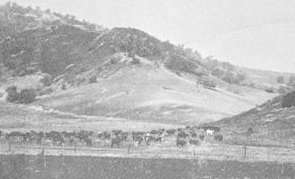 Cattle On Rancho San Rafael
Cattle On Rancho San Rafael
4 Dec 1797 - San Gabriel - Mission San Gabriel Arcangel
 RETIREMENT REQUEST
RETIREMENT REQUEST: Jose Maria requests retirement from further military service. According to his own statement, he was so weary of military life.
He writes a letter to governor Borica which is transmitted through his commanding officer, Lieutenant Grajera.
Jose Maria explains to the governor that he is "much afflicted with the dropsy," and "entirely incapable for all duty as a sentinel or a scout."
As for moving to one of the pueblos, Jose Maria explains:
"I cannot, Sir, risk myself to go to one of the Pueblos, where not having any son (although I have five small girls, and one small male child) that might be able to assist me,
I would have to suffer the various fatigues in which all persons, although for good, share in common. I know that I am already incapable [of such duties].
I require greater ease, and cannot persuade myself that your Excellency's compassion can deny it to me."
29 Dec 1797 - San Gabriel - Mission San Gabriel Arcangel
 MISSION BAPTISM AND DEATH RECORDS
MISSION BAPTISM AND DEATH RECORDS: Jose Maria's eighth child is born, a daughter, Manuela Tomasa de los Inocentes Verdugo.
She is baptized at Jose Maria's house in peril of death and dies same day. She is buried the same day at the mission.
1798 - Rancho San Rafael
 NEW/CONFIRMATORY LAND GRANT
NEW/CONFIRMATORY LAND GRANT: Jose Maria receives a new or confirmatory land grant for Rancho San Rafael from Governor Borica.
12 Jan 1798 - San Gabriel - Mission San Gabriel Arcangel
 RETIREMENT GRANTED
RETIREMENT GRANTED: Governor Diego de Borica formallly consents to Jose Maria's request for retirement, adding that he "ought to increase the number of his sheep," and to "...treat well the Indians both Christian and Gentiles that live near the Rancho, with that love and charity so much recommended by the laws, but not for this to forbear living with the proper precaution so as to avoid all insults by the Indians."
24 Apr 1798 - San Gabriel - Mission San Gabriel Arcangel

 MISSION DEATH RECORD
MISSION DEATH RECORD: Jose Maria's mother, Maria Ygnacia de la Concepcion Carrillo, dies, and is buried beneath the floor of the mission.
31 Dec 1798 - Los Angeles - Pueblo
 1798 PUEBLO POBLADORES LIST
1798 PUEBLO POBLADORES LIST: Jose Maria is listed as Jose Maria Verdugo, cabo invalido (corporal retired soldier).
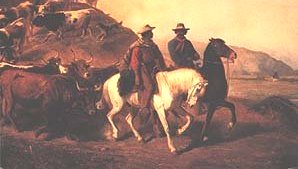 Antonio Rosas Joins Jose Maria On The Rancho
Antonio Rosas Joins Jose Maria On The Rancho
1799 - Rancho San Rafael
 RANCHO HELP REQUESTED
RANCHO HELP REQUESTED: Just before moving to the rancho, Jose Maria writes a letter to Commandant Lieutenant Grajero explaining
that his brother-in-law won't be helping him on the rancho as expected, and requests the commandant permit a Los Angeles Pueblo citizen,
Antonio Rosas, to settle on the rancho with him.
31 Dec 1799 - Los Angeles - Pueblo
 1799 PUEBLO POBLADORES LIST
1799 PUEBLO POBLADORES LIST: Jose Maria is listed as Jose Maria Verdugo, cabo invalido (corporal retired soldier).
22 Aug 1800 - Los Angeles - Pueblo
 MISSION BAPTISM RECORD
MISSION BAPTISM RECORD: Jose Maria's ninth child is born, a boy, and is baptized Jose Maria Verdugo, after his father, in Los Angeles by Maria Ygnacia Amador, in peril of death.
He dies the same day, and is buried at Mission San Gabriel the next day.
1 Jan 1801 - Rancho San Rafael
 LETTER FROM PRESIDIO COMMANDANT
LETTER FROM PRESIDIO COMMANDANT: Jose Maria receives a letter from the Royal Presidio of San Diego Commandant, Lieutenant Manuel Rodriguez, addresssed "To the retired corporal with the grade of Sergeant, Joseph Maria Verdugo, at his rancho of San Rafael" regarding butter he had received from Jose Maria, and requesting more.
14 Apr 1801 - Rancho San Rafael
 LETTER FROM PRESIDIO COMMANDANT
LETTER FROM PRESIDIO COMMANDANT: Jose Maria receives another letter from Commandant Rodriquez requesting more butter.
May 1801 - Los Angeles - Pueblo

 MISSION DEATH RECORD
MISSION DEATH RECORD: Jose Maria's seventh child, 5 1/2-year-old daughter, Maria del Pilar Lopez Verdugo, dies and is buried on 2 May 1801 at Mission San Gabriel.
 Rancho Wheat
Rancho Wheat
20 Jul 1801 - Rancho San Rafael
 WHEAT EXPORTATION
WHEAT EXPORTATION: From a list sent to Governor Jose de Arrillaga from the Pueblo de Los Angeles containing the names and amounts of those able to supply wheat for exportation to San Blas, Baja California, (under authorization from the viceroy), Jose Maria was listed as having 200 fanegas (over 500 bushels) to export.
5 Nov 1801 - Los Angeles - Pueblo
 MISSION BAPTISM RECORD
MISSION BAPTISM RECORD: Jose Maria's tenth child is born, a daughter, Maria Rafaela Antonia Verdugo, and is baptized the next day at Mission San Gabriel.
1804 - Los Angeles - Pueblo
 PUEBLO EASTER LIST
PUEBLO EASTER LIST: This list reveals the number of persons who are obliged to fulfill the precept of Our Holy Mother, the Church, who correspond with the residents of this Pueblo of the Queen of the Angels and ranches under its jurisdiction in the year 1804. Jose Maria and his family are listed as; Jose Maria Verdugo and his wife Maria Cabo Encarnacion Lopez, Maria Antonia, Maria Ygnacia, Julio.
Feb 1804 - Rancho San Rafael

 MISSION DEATH RECORD
MISSION DEATH RECORD: Jose Maria's tenth child, a 2-year-old daughter, Maria Rafaela Antonia Verdugo, dies and is buried on 8 Feb 1804 at Mission San Gabriel.
Jan 1807 - Rancho San Rafael

 MISSION BAPTISM AND DEATH RECORDS
MISSION BAPTISM AND DEATH RECORDS: Jose Maria's eleventh child is born, a daughter, Maria Juana Verdugo, is baptized on the Verdugo ranch in extreme necessity and dies a few days later. She is buried in Jan 1807 at Mission San Gabriel.
1814 - Rancho San Rafael
 LAND DISPUTE WITH MISSION SAN GABRIEL ARCANGEL
LAND DISPUTE WITH MISSION SAN GABRIEL ARCANGEL: A new priest, Joaquin Pascual Nuez, orders replacement of the mission's sheep rancho on Jose Maria's land. Jose Maria complains to Governor Arrillaga, who orders the sheep removed at once.
28 Jul 1817 - Rancho San Rafael
 REPORT TO GOVERNOR
REPORT TO GOVERNOR: Jose Maria reports to the governor the number of his stock on Rancho San Rafael.
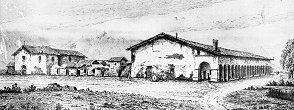 Mission San Fernando Rey
Mission San Fernando Rey
Sep 1817 - Rancho San Rafael
 LAND DISPUTE WITH MISSION SAN FERNANDO REY
LAND DISPUTE WITH MISSION SAN FERNANDO REY: Mission Father Pedro Munoz petitions Governor Sola, claiming lands which infringe on Rancho San Rafael.
Jose Maria complains to Governor Sola, who orders Guillermo Cota, a military commissioner of the Pueblo of Los Angeles, to establish the boundaries of land in dispute, which is done using markers alder trees, hollow oaks, and mounds of stones.
Oct 1817 - Rancho San Rafael

 MISSION DEATH RECORD
MISSION DEATH RECORD: Jose Maria's wife, 56-year-old Maria Encarnacion Lopez, dies. She is buried on 10 Oct 1817 at Mission San Gabriel.
1828 - Rancho San Rafael
 FAILING HEALTH AND OLD AGE
FAILING HEALTH AND OLD AGE: Seventy-seven-year-old Jose Maria's failing health and old age are beginning to tell. He contininues to ride with this vaqueros. When not visiting neighboring ranchos, or in the Pueblo, he can be found entertaining visitors in the long, low adobe ranch house, or watching the branding of his calves. Alcaldes (mayors), regidores (council members), padres, soldiers, and settlers are frequent visitors at the rancho.
13 Aug 1828 - Rancho San Rafael
 WILL DRAWN UP
WILL DRAWN UP: Great Grandpa Jose Maria draws up his will.
As his health fails, Jose Maria, ill, though in full possession of his faculties, writes ... "Men have to die and that such may take place at any hour without knowing just when. Firmly believing as I do in the Mystery of the Most Holy Trinity, the Father, the Son, and the Holy Ghost, three persons distinct, and one only true God, and in all and everything that our Holy Mother church believes and acknowledges ... I order and make my testament."
With these words (before Jose Antonio Pico, Juan Maria Marron and Francisco Morales), Jose Maria draws up his will, leaving Rancho San Rafael to his son, Julio, and blind daughter, Catalina.
1829 - San Fernando - Mission San Fernando Rey
 ANOTHER LAND DISPUTE WITH MISSION SAN FERNANDO REY
ANOTHER LAND DISPUTE WITH MISSION SAN FERNANDO REY: A dispute again develops between the Jose Maria and Mission San Fernando. The mission's mayodomo refuses to remove mission cattle who entered the unfenced Rancho San Rafael. The mission also plants crops on the rancho without permission.
Jose Maria appeals to the Governor Jose Echeandia who orders the mission to withdraw from the major part of the disputed territory, and gives a small portion of land to the mission.
5 Sep 1829 - Rancho San Rafael
 ADDITIONS TO WILL
ADDITIONS TO WILL: Jose Maria is so weak he cannot leave his bed. He summmons the Alcalde of Los Angeles (his old friend, Guillermo Cota) to his bedside, and in the presence of his family and witnesses adds several codicils to his will. In his weakened condition he cannot sign the document, and permits his son Julio to do so for him.
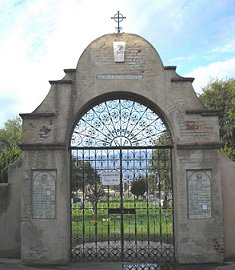 Gate to Mission San Gabriel Cemetery
Gate to Mission San Gabriel Cemetery
12 Apr 1831 - Rancho San Rafael

 MISSION DEATH RECORD
MISSION DEATH RECORD: Great Grandpa Jose Maria Verdugo dies on his beloved Rancho San Rafael. His life closes at the approximate age of 80-years-old.
The following day, with his family and many of his friends in attendance, Jose Maria is buried at Mission San Gabriel by Father Geronimo Boscana.
Catalina and Julio eventually legally divided up the rancho in 1861, thirty years after Jose Maria's death, with Julio taking the southern portion of the rancho and Catalina the northern portion.
It is worthy to note that Jose's soldier's hat and sword were exhibited at the California State Fair in 1892, as was his son, Julio's sword, according to the September 1892 edition of the
Los Angeles Times newspaper.
Many historian's mention the beauty of Julio's Rancho San Rafael to the likening of a "garden of eden" with a vineyard, orchard, corn, wheat, beans, garbanzos, pumpkins, melons, squashes, tomatoes, cabbage and other crops.
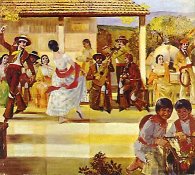 Fandango
Fandango
Julio was also known to have fancy barbecues and fandangos that lasted days at a time, which included annual rodeos and horse racing.
Stories have been told of how Julio would dress in his finest regalia, his horse decked out in silver harness and saddle, and he would parade into Los Angeles from the Verdugo road with his thirteen sons at his side.
However, that is another tale to be told in a separate
Feature Article,
The Loss Of Rancho San Rafael.



















 PORTOLA EXPEDITION: Jose Maria is listed as Josef Maria Verdugo on list of expedition members prepared by Marie E. Northrup; her reference sources included mission and garrison records, California Padrones (censuses), pioneer indexes, and other early-California-history books and records.
PORTOLA EXPEDITION: Jose Maria is listed as Josef Maria Verdugo on list of expedition members prepared by Marie E. Northrup; her reference sources included mission and garrison records, California Padrones (censuses), pioneer indexes, and other early-California-history books and records.

 MISSION BAPTISM RECORD: Jose Maria is listed as a padrino (godfather) for a converted Indian's baptism.
MISSION BAPTISM RECORD: Jose Maria is listed as a padrino (godfather) for a converted Indian's baptism.

 ALTA CALIFORNIA PADRON (CENSUS): Jose Maria is listed as being attached to the garrison
ALTA CALIFORNIA PADRON (CENSUS): Jose Maria is listed as being attached to the garrison



 MISSION DEATH RECORD: Jose Maria's father, Juan Diego Verdugo, dies and is buried inside the church on 24 January 1780. Afterwards Jose Maria's mother, Maria Ygnacia Carrillo Verdugo, moves to the mission to reside.
MISSION DEATH RECORD: Jose Maria's father, Juan Diego Verdugo, dies and is buried inside the church on 24 January 1780. Afterwards Jose Maria's mother, Maria Ygnacia Carrillo Verdugo, moves to the mission to reside.

 LAND GRANT: Jose Maria requests and receives the third land grant in Alta California from Governor Fages for 36,403 acres.
LAND GRANT: Jose Maria requests and receives the third land grant in Alta California from Governor Fages for 36,403 acres.







